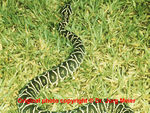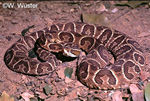|
Bothrops alternatus
|
![Bothrops alternatus ( Urutu ) [ Original photo copyright © Dr Jurg Meier ]](images/snakes/SNP03851.jpg)
|
|
Family: Viperidae
|
|
Subfamily: Crotalinae
|
|
Genus: Bothrops
|
|
Species: alternatus
|
Common Names
Urutu , Yarara , Half-moon Viper
|
Local Names
Acacusu , Boicoatiara , Boicotiara , Coatiara , Cotiara , Cruzeiro , Cruzeira , Cruzera , Crucera , De la Cruz , Jararaca de Agosto , Jararaca Rabo-de-Porco , Kiririog-aka-kurussu , Mboi Cuatia , Mboi-cuatia , Mboi-kwatiara , Urutu , Vibora de la Cruz, Yarara , Yarara Acacusu , Yarara Grande
|
Region
South America
|
Countries
Argentina, Brazil, Paraguay, Uruguay
|
|

|
|
|
|
Taxonomy and Biology
|
|
Adult Length: 0.90 m
|
General Shape
Medium to large in length, heavy bodied pitviper. Can grow to a maximum of over 1.70 metres. Head is broad, flattened, lance shaped when viewed from above and distinct from narrow neck. Snout is not elevated. Eyes are medium in size with vertically elliptical pupils. Dorsal scales strongly keeled.
|
Habitat
Tropical, semitropical and temperate deciduous forest, pampas grassland, open fields and rocky regions and low lying swamp and marsh regions. Frequently encountered in sugar cane plantations in the region. Usually found in open areas.
|
Habits
Terrestrial and mainly a nocturnal snake. Often hides it head if disturbed. Can be highly irascible if provoked.
|
Prey
Feeds almost exclusively on mammals especially rodents.
|
|
|
|
Venom
|
Average Venom Qty
60 to 100 mg ( dry weight ), Minton (1974) ( Ref : R000504 ).
Female ( n=34 ) = 281 mg, Newborn = 149 mg. Furtado et al (1991) ( Ref : R000651 ).
Minas Gerais, Brazil : 100 mg ( dry weight ) ( range 42 to 151 ), Sanchez et al (1992) ( Ref : R000690 ).
Argentina : 295.0 ± 41 mg ( dry weight ) = 32.7 ± 10.0 mg venom / 100 g body weight, De Roodt et al (1988) ( Ref : R000870 ).
|
General: Venom Neurotoxins
Probably not present
|
General: Venom Myotoxins
Probably not present
|
General: Venom Procoagulants
Mixture of procoagulants
|
General: Venom Anticoagulants
Possibly present but not clinically significant
|
General: Venom Haemorrhagins
Possibly present
|
General: Venom Nephrotoxins
Probably not present
|
General: Venom Cardiotoxins
Probably not present
|
General: Venom Necrotoxins
Possibly present
|
General: Venom Other
Unknown
|
|
|
|
Clinical Effects
|
General: Dangerousness
Unknown, but potentially lethal envenoming, though unlikely, cannot be excluded.
|
|
General: Rate of Envenoming: >80%
|
|
General: Untreated Lethality Rate: Unknown but lethal potential cannot be excluded
|
General: Local Effects
Marked local effects; pain, severe swelling, bruising, blistering, necrosis
|
General: Local Necrosis
Uncommon but can be moderate to severe
|
General: General Systemic Effects
Variable non-specific effects which may include headache, nausea, vomiting, abdominal pain, diarrhoea, dizziness, collapse or convulsions
|
General: Neurotoxic Paralysis
Does not occur, based on current clinical evidence
|
General: Myotoxicity
No case reports for this species, but related species can cause systemic myolysis
|
General: Coagulopathy & Haemorrhages
Very common, coagulopathy + haemorrhagins causing bleeding is major clinical effect
|
General: Renal Damage
No case reports for this species, but related species can cause renal failure secondary to coagulopathy or myolysis.
|
General: Cardiotoxicity
Does not occur, based on current clinical evidence
|
General: Other
Unknown
|
|
|
|
First Aid
|
|
Description: First aid for bites by Viperid snakes likely to cause significant local injury at the bite site (see listing in Comments section).
|
Details
1. After ensuring the patient and onlookers have moved out of range of further strikes by the snake, the bitten person should be reassured and persuaded to lie down and remain still. Many will be terrified, fearing sudden death and, in this mood, they may behave irrationally or even hysterically. The basis for reassurance is the fact that many venomous bites do not result in envenoming, the relatively slow progression to severe envenoming (hours following elapid bites, days following viper bites) and the effectiveness of modern medical treatment.
2. The bite wound should not be tampered with in any way. Wiping it once with a damp cloth to remove surface venom is unlikely to do much harm (or good) but the wound must not be massaged.
3. All rings or other jewellery on the bitten limb, especially on fingers, should be removed, as they may act as tourniquets if oedema develops.
4. The bitten limb should be immobilised as effectively as possible using an extemporised splint or sling; if available, crepe bandaging of the splinted limb is an effective form of immobilisation.
5. If there is any impairment of vital functions, such as problems with respiration, airway, circulation, heart function, these must be supported as a priority. In particular, for bites causing flaccid paralysis, including respiratory paralysis, both airway and respiration may be impaired, requiring urgent and prolonged treatment, which may include the mouth to mask (mouth to mouth) technique of expired air transfer. Seek urgent medical attention.
6. Do not use Tourniquets, cut, suck or scarify the wound or apply chemicals or electric shock.
7. Avoid peroral intake, absolutely no alcohol. No sedatives outside hospital. If there will be considerable delay before reaching medical aid, measured in several hours to days, then give clear fluids by mouth to prevent dehydration.
8. If the offending snake has been killed it should be brought with the patient for identification (only relevant in areas where there are more than one naturally occurring venomous snake species), but be careful to avoid touching the head, as even a dead snake can envenom. No attempt should be made to pursue the snake into the undergrowth as this will risk further bites.
9. The snakebite victim should be transported as quickly and as passively as possible to the nearest place where they can be seen by a medically-trained person (health station, dispensary, clinic or hospital). The bitten limb must not be exercised as muscular contraction will promote systemic absorption of venom. If no motor vehicle or boat is available, the patient can be carried on a stretcher or hurdle, on the pillion or crossbar of a bicycle or on someone's back.
10. Most traditional, and many of the more recently fashionable, first aid measures are useless and potentially dangerous. These include local cauterization, incision, excision, amputation, suction by mouth, vacuum pump or syringe, combined incision and suction ("venom-ex" apparatus), injection or instillation of compounds such as potassium permanganate, phenol (carbolic soap) and trypsin, application of electric shocks or ice (cryotherapy), use of traditional herbal, folk and other remedies including the ingestion of emetic plant products and parts of the snake, multiple incisions, tattooing and so on.
|
|
|
|
Treatment
|
Treatment Summary
This treatment advice is general for most Bothrops species. Bites will vary from minor to life threatening. Therefore manage all bites as potentially major. Look for moderate to severe local effects, including pain, swelling, potential for fluid shifts and hypovolaemic shock, blistering, necrosis, abscess formation. Systemic effects may be minor or severe, possibly including coagulopathy and bleeding, kidney damage, even myolytic muscle damage. All cases with significant systemic effects require IV antivenom, as will most cases with significant local effects.
|
Key Diagnostic Features
Local pain, swelling, blistering, necrosis + coagulopathy, bleeding
|
General Approach to Management
All cases should be treated as urgent & potentially lethal. Rapid assessment & commencement of treatment including appropriate antivenom (if indicated & available) is mandatory. Admit all cases.
|
Antivenom Therapy
Antivenom is the key treatment for systemic envenoming. Multiple doses may be required.
|
| 1. Antivenom Code: SAmICP01
|
|
Antivenom Name: Polyvalent Antivenom
|
|
Manufacturer: Instituto Clodomiro Picado
|
|
Phone: ++506-2511-7888
|
Address: Contiguo a la plaza de deportes,
Dulce Nombre de Coronado.
San José
Costa Rica
|
|
Country: Costa Rica
|
| 2. Antivenom Code: SAmIBB03
|
|
Antivenom Name: Soro antibotropico-laquetico
|
|
Manufacturer: Instituto Butantan
|
|
Phone: +55-11-3726-7222
|
Address: Av. Vital Brasil, 1500 Butanta
05503-900
Sao Paulo - SP
|
|
Country: Brazil
|
| 3. Antivenom Code: SAmIBB05
|
|
Antivenom Name: Soro botropico
|
|
Manufacturer: Instituto Butantan
|
|
Phone: +55-11-3726-7222
|
Address: Av. Vital Brasil, 1500 Butanta
05503-900
Sao Paulo - SP
|
|
Country: Brazil
|
| 4. Antivenom Code: SAmFED01
|
|
Antivenom Name: Soro Antibotropico
|
|
Manufacturer: Fundacao Ezequiel Dias - FUNED
|
|
Phone: ++55-31-3371-9525
|
Address: Rua Conde Pereira Carneiro, 80 - Gameleria
Belo Horizonte, MG - CEP 30510-010
|
|
Country: Brazil
|
| 5. Antivenom Code: SAmFED02
|
|
Antivenom Name: Soro Anti-botropico-crotalico
|
|
Manufacturer: Fundacao Ezequiel Dias - FUNED
|
|
Phone: ++55-31-3371-9525
|
Address: Rua Conde Pereira Carneiro, 80 - Gameleria
Belo Horizonte, MG - CEP 30510-010
|
|
Country: Brazil
|
| 6. Antivenom Code: SAmFED04
|
|
Antivenom Name: Soro Antibotropico-laquetico
|
|
Manufacturer: Fundacao Ezequiel Dias - FUNED
|
|
Phone: ++55-31-3371-9525
|
Address: Rua Conde Pereira Carneiro, 80 - Gameleria
Belo Horizonte, MG - CEP 30510-010
|
|
Country: Brazil
|
| 7. Antivenom Code: SAmNIA01
|
|
Antivenom Name: Antibothrops Bivalente
|
Manufacturer: Instituto Nacional de Produccion de Biologics
A.N.L.I.S.
|
|
Phone: ++54-11-4303-1806 (to 11)
|
Address: Avdo. Velez Sarsfield 563,
CP 1281 Buenos Aires,
|
|
Country: Argentina
|
| 8. Antivenom Code: SAmNIA02
|
|
Antivenom Name: Antibothrops Tetravalente
|
Manufacturer: Instituto Nacional de Produccion de Biologics
A.N.L.I.S.
|
|
Phone: ++54-11-4303-1806 (to 11)
|
Address: Avdo. Velez Sarsfield 563,
CP 1281 Buenos Aires,
|
|
Country: Argentina
|
| 9. Antivenom Code: SAmNIA05
|
|
Antivenom Name: Tropical trivalente
|
Manufacturer: Instituto Nacional de Produccion de Biologics
A.N.L.I.S.
|
|
Phone: ++54-11-4303-1806 (to 11)
|
Address: Avdo. Velez Sarsfield 563,
CP 1281 Buenos Aires,
|
|
Country: Argentina
|
| 10. Antivenom Code: SAmIHU01
|
|
Antivenom Name: IgG (Fab2)' Suero antiofidico bivalente antibothropico
|
|
Manufacturer: Instituto de Higiene
|
|
Phone: ++598-2-487-3073
|
Address: Alfredo Navarro 3051,
C.P. 11600
Montevideo,
|
|
Country: Uruguay
|
| 11. Antivenom Code: SAmIBB07
|
|
Antivenom Name: Soro antibotropico-crotalico
|
|
Manufacturer: Instituto Butantan
|
|
Phone: +55-11-3726-7222
|
Address: Av. Vital Brasil, 1500 Butanta
05503-900
Sao Paulo - SP
|
|
Country: Brazil
|
| 12. Antivenom Code: SAmIBA01
|
|
Antivenom Name: Suero Antifidico Polivalente BIOL (Suero Antiofidoco para mordedura de Yarara, De la Cruz y Cscabel)
|
|
Manufacturer: Instituto Biologico Argentino S.A.I.C.
|
|
Phone: ++54-11-4953-7215
|
Address: Jose E. Uriburu 153
C1027 AAC Buenos Aires
|
|
Country: Argentina
|
| 13. Antivenom Code: SAmIBM06
|
|
Antivenom Name: Antivipmyn
|
|
Manufacturer: Instituto Bioclon
|
|
Phone: ++56-65-41-11
|
Address: Calzada de Tlalpan No. 4687
Toriello Guerra
C.P. 14050
Mexico, D.F.,
|
|
Country: Mexico
|
|
|
|
Images
|

|

|
|
|
|
|
|
Bothrops alternatus ( Urutu ) [ Original photo copyright © Dr Jurg Meier ]
|
Bothrops alternatus ( Urutu ) [ Original photo copyright © Dr Wolfgang Wuster ]
|
|
|
|
|
|
|
|



